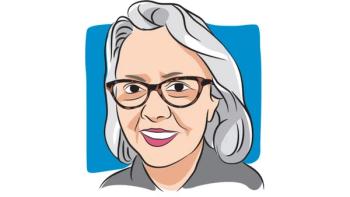
With Cancer I Ask Myself, ‘What are the Odds?’
Oftentimes, I find myself realizing that the statistics related to my cancer diagnosis are like an elephant in the room.
I bought a cute stuffed pink elephant with a purple bow in its ear. I now bring it with me to all my doctor’s appointments. When faced with a potentially terminal illness, I find it eases the tension for both my doctors and me to discuss a very sensitive topic which is the reality of my situation, prognosis, etc. — hence the “elephant in the room.” The elephant also serves as a reminder of the need to ask the tough questions that need answering.
I am not a gambling person, but I understand odds and statistics. When diagnosed with triple-negative breast cancer (TNBC), I was told the statistics of diagnosis of this aggressive cancer is 10–15% of breast cancers. I didn’t like hearing that. Who does?
My reactions to treatments were probably as rare as the odds of getting TNBC. From chemo I have permanent hearing loss, neuropathy in both feet, was hospitalized with double lung pneumonia, inflammatory colitis, full-body blistery rash, lupus diagnosis, hair loss, fatigue, pain, diarrhea and anaphylactic reactions.
Five months after a lumpectomy (which had clean margins), I found a small pimple on my breast. It wouldn’t go away. A biopsy performed by my breast surgeon revealed the breast cancer had metastasized to the skin on my chest. In the two short weeks that we awaited the biopsy results, a huge tumor grew in my breast, the likes of which my breast surgeon, in her 17 years of practice, had never seen anything like it. The tumor grew so fast and was so painful that I had two days’ notice that I was getting a mastectomy. What are the odds of that?
From a small pimple, I developed a 10.8-cm tumor in my breast and another 1.5-cm tumor below the pimple. What could cause such an impressively rapid tumor development? Slides of the tumor were sent to two separate medical facilities which arrived at the same conclusion. My tumor had mutated. My new diagnosis was TNBC with small cell carcinoma of the breast.
I was told that small cell carcinoma of the breast is a very rare, very aggressive cancer that affects less than 1% of all breast cancers. Those are horrible odds. It was the aggression of this type of cancer that propelled a small innocuous pimple to become a super-sized tumor in an astonishing record-breaking time.
Treatment recommendations included 34 rounds of radiation therapy. Once again, I defied the typical radiation reaction side effect odds and had horrendous negative outcomes after my first and only treatment. My chest wall was burned, I have searing pain in my armpit and lost my full range of motion in my left arm. It appears my reactions to cancer treatments are as rare as my new diagnosis. In my opinion, the list of side effects of the suggested chemotherapy for this rare cancer are as long as the criminal records of Bonnie and Clyde or Billy the Kid.
It was explained to me that small cell carcinoma of the breast behaves like lung cancer. The cancer cells leave the lymph nodes and inevitably work their way into the blood stream with an end goal of attacking the organs of the body. Due to the aggressive nature of this rare cancer, it appears their pace may be likened to a marathon race. These cells want to go far, and they want to get there fast.
Even without remembering to bring my elephant to my primary care doctor’s visit, she broached the subject of palliative care with me as I have opted out of treatments that will cause me more pain and damage than the uninvited, unwelcome disease that has invaded my body. It was explained to me that palliative care is concerned with a person’s quality of life. It is sometimes referred to as “supportive care.” It is NOT hospice, although often confused with that title.
The more I researched palliative care, the more intrigued I have become with utilizing their services. Maybe it will be like having someone in my corner while I work my way around the wrestling ring of cancer, perhaps supporting me and when the time comes, realize when it is time to throw in the towel. I mean that in a positive way, a realistic way, a humane way. That’s what I need and want.
For now, I’m still here! I am going for weekly physical therapy sessions to build up my strength. I continue to educate myself and my providers on my personal needs, preferences, and wants. My boxing gloves are still firmly secured to my hands, and I will continue to fight the odds but this time, I have something big and powerful helping me every step of the way — my pink elephant.
This post was written and submitted by Kiki Peppard. The article reflects the views of Kiki Peppard and not of CURE®. This is also not supposed to be intended as medical advice.
For more news on cancer updates, research and education, don’t forget to




